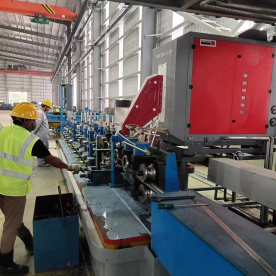[Solid state HF welder for metal processing]Revolutionizing Metal Processing: The Advantages and Innovations of Solid State HF Welder Technology
News 2024-9-20

Revolutionizing Metal Processing: The Advantages and Innovations of Solid State HF Welder Technology
Understanding Solid State HF Welding

Revolutionizing Metal Processing: The Advantages and Innovations of Solid State HF Welder Technology
The Advantages of Solid State HF Welders

Revolutionizing Metal Processing: The Advantages and Innovations of Solid State HF Welder Technology
2. **Versatility**: Solid state HF welding technology can be employed across various materials, including metals such as steel, aluminum, and copper. This versatility makes solid state HF welders suitable for a wide range of industries, such as automotive, aerospace, construction, and electronics, where different metals may need to be processed.
3. **High Efficiency**: The solid state design allows for quick heating and cooling cycles, which makes the process highly efficient. These welders require less energy compared to traditional welding methodologies, meaning that manufacturers can achieve significant cost savings without sacrificing quality. As energy costs continue to rise, this aspect becomes increasingly attractive.
4. **Integration with Automation**: With the advent of Industry 4.0, solid state HF welders are generally easier to integrate into automated systems compared to older technologies. This facilitates greater efficiency, as tasks can be carried out quickly and consistently, minimizing human error and the time required for manual operations.
5. **Reduced Heat-Affected Zone (HAZ)**: The HAZ in welding refers to the area around the weld that experiences changes in microstructure due to excessive heat. Solid state HF welding produces a much smaller HAZ, which is vital for maintaining the overall strength and integrity of the material being processed. This attribute is particularly important for critical applications where structural integrity is paramount.
Innovations in Solid State HF Welding Technology
Recent advancements in solid state HF welding technology have further expanded its capabilities and applications. Innovations such as intelligent control systems allow for real-time monitoring and adjustments during the welding process, ensuring optimal results. Additionally, the development of modular designs means that manufacturers can customize their welding setups for specific applications, saving both time and resources.
Furthermore, software advancements, including the use of simulation techniques, enable manufacturers to predict welding outcomes and refine their processes before physical production. This ability to simulate welding scenarios significantly reduces trial-and-error phases, saving resources and minimizing waste.
Future Potential of Solid State HF Welding in Metal Processing
As industries continue to seek innovative solutions that enhance productivity and sustainability, the potential applications for solid state HF welders seem boundless. The ongoing exploration into new materials, including lightweight composites and advanced alloys, presents exciting opportunities for this technology to further enhance the metal processing sector.
Moreover, as environmental regulations become stricter, the efficient energy consumption and reduced emissions associated with solid state HF welding can make it a preferred method for eco-conscious manufacturers seeking sustainable practices.
Conclusion
Solid state HF welders represent a significant leap forward in the field of metal processing, combining precision, efficiency, and versatility in a way that traditional welding technologies cannot match. As the manufacturing landscape continues to shift towards more technologically advanced solutions, these welders will undoubtedly play a critical role in shaping the industry's future. Addressing the challenges of modern production while minimizing environmental impact, solid state HF welding is an essential tool for any progressive metal processing operation looking to stay ahead of the competition.
